Assignment Title
VerifiedAdded on 2019/12/04
|13
|3468
|153
Essay
AI Summary
As a renowned coffee brand, Starbucks aims to attract new customers and retain existing ones by leveraging a low-cost leadership strategy. This approach enables the company to offer products at competitive prices, thereby maintaining its market share and competitiveness. By compromising on product quality, Starbucks can maintain its pricing strategy, which is essential for the company's growth. Moreover, this strategy helps in consolidating large numbers of customers with the brand, ultimately leading to increased profits and sales. To achieve this, Starbucks must conduct thorough analysis of its external environment before selecting a particular tactic, ensuring that it is moving in the right direction.
Contribute Materials
Your contribution can guide someone’s learning journey. Share your
documents today.
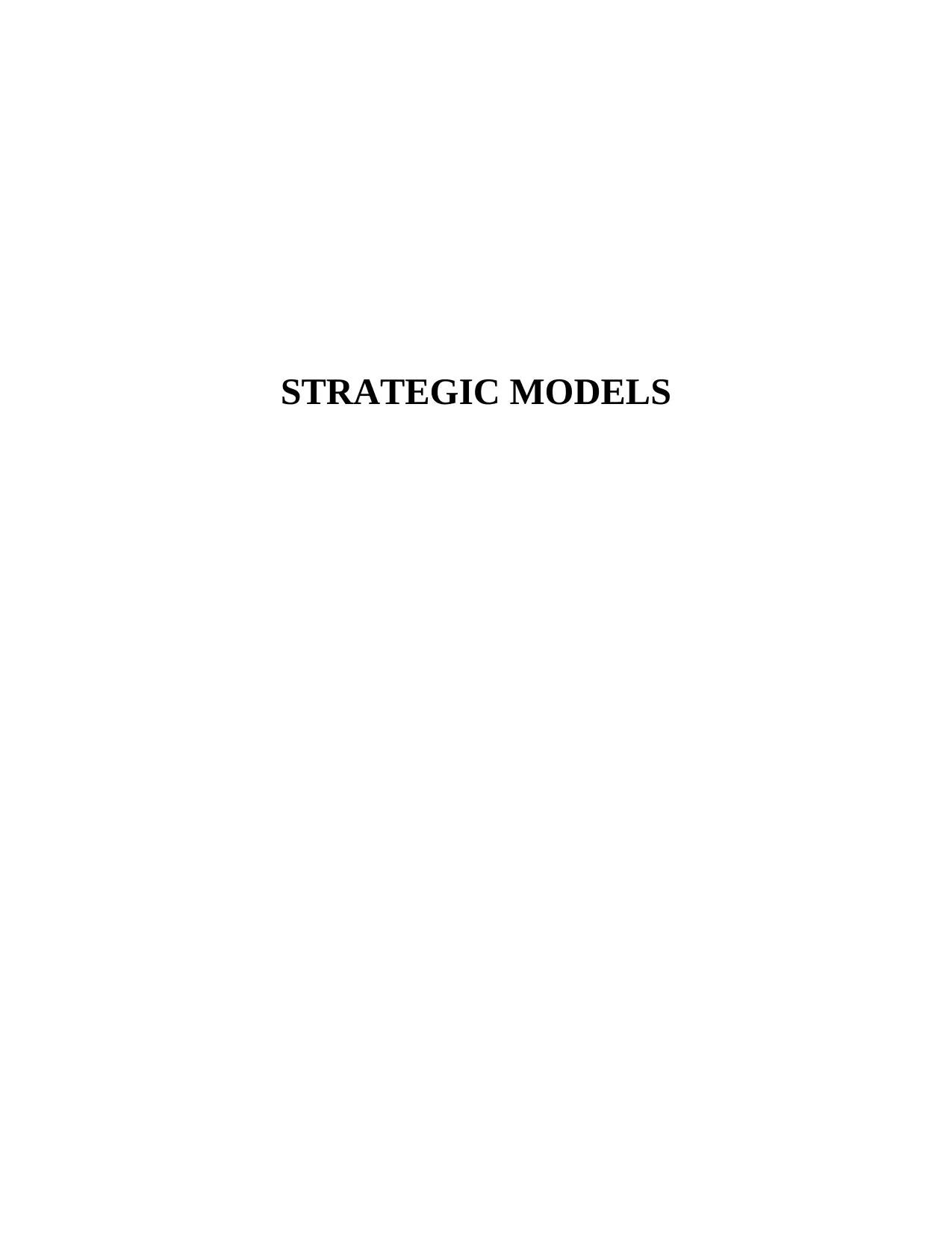
STRATEGIC MODELS
Secure Best Marks with AI Grader
Need help grading? Try our AI Grader for instant feedback on your assignments.
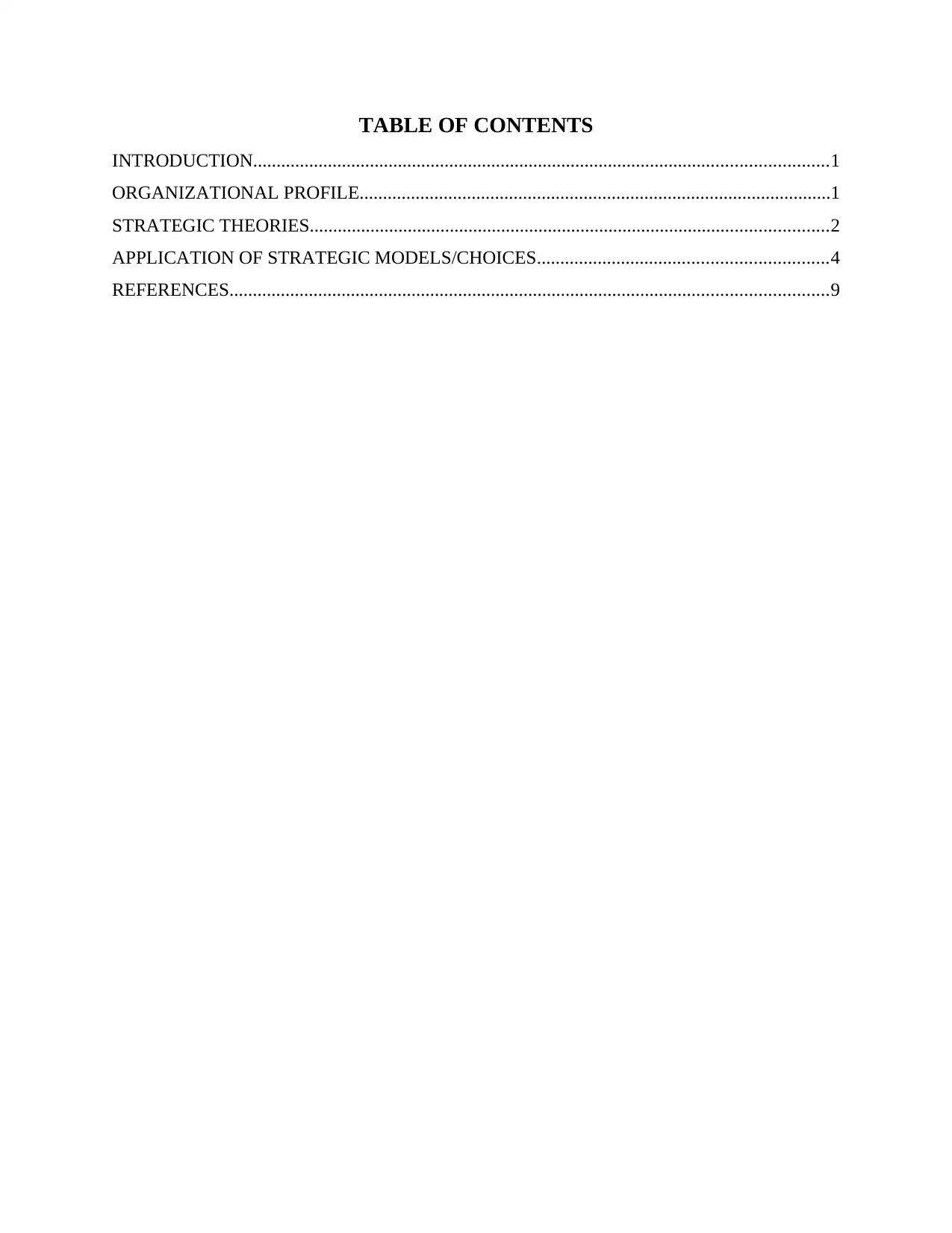
TABLE OF CONTENTS
INTRODUCTION...........................................................................................................................1
ORGANIZATIONAL PROFILE.....................................................................................................1
STRATEGIC THEORIES...............................................................................................................2
APPLICATION OF STRATEGIC MODELS/CHOICES..............................................................4
REFERENCES................................................................................................................................9
INTRODUCTION...........................................................................................................................1
ORGANIZATIONAL PROFILE.....................................................................................................1
STRATEGIC THEORIES...............................................................................................................2
APPLICATION OF STRATEGIC MODELS/CHOICES..............................................................4
REFERENCES................................................................................................................................9

ILLUSTRATION INDEX
Illustration 1: Popularity of different brands among drinkers.........................................................2
Illustration 2: Ansoff matrix............................................................................................................3
Illustration 3: Bowman's strategy clock...........................................................................................4
Illustration 1: Popularity of different brands among drinkers.........................................................2
Illustration 2: Ansoff matrix............................................................................................................3
Illustration 3: Bowman's strategy clock...........................................................................................4

INTRODUCTION
In order to work in a business environment, manager of firm will have to formulate the
number of strategies. This is because, by making the selection of an appropriate tactic only, firms
can mark significant presence in the markets where it is operating its business operations
(Shavarini and et.al., 2013). Here, with an aim to carry out the present report, Starbucks is
selected. The report will provide detailed explanation regarding number of strategic models
which manager of cited firm can use in order to make the strategic choices in an effectual way.
Finally, at the end of report, conclusion will be drawn which will depict the overall findings
related to the study.
ORGANIZATIONAL PROFILE
Starbucks is a public limited American coffee company and chain which performs its
business operations in number of nations. Organization has its recognized brand name in food
and beverage industry. In addition to this, firm was found in the year 1971 by three persons who
are named as Gordon Bowker, Zev Siegl and Jerry Baldwin. Starbucks has different subsidiary
organizations also (Starbucks, 2016). Furthermore, it has a team of around 191000 employees
who put their all sort of efforts with an aim to attain the goals and objectives of enterprise.
Company’s core product is coffee but along with it, organization also offers varied other goods
such as smoothies, sandwiches, tea and backed goods etc. (Rossi, 2010).
Besides this, Starbucks has the mission to inspire and nurture the spirits of human.
However, it has the vision is to become a prime provider of the finest coffee in the world. In
addition to this, organization basically faces competition from the firms like McDonald and
Costa Coffee.
1
In order to work in a business environment, manager of firm will have to formulate the
number of strategies. This is because, by making the selection of an appropriate tactic only, firms
can mark significant presence in the markets where it is operating its business operations
(Shavarini and et.al., 2013). Here, with an aim to carry out the present report, Starbucks is
selected. The report will provide detailed explanation regarding number of strategic models
which manager of cited firm can use in order to make the strategic choices in an effectual way.
Finally, at the end of report, conclusion will be drawn which will depict the overall findings
related to the study.
ORGANIZATIONAL PROFILE
Starbucks is a public limited American coffee company and chain which performs its
business operations in number of nations. Organization has its recognized brand name in food
and beverage industry. In addition to this, firm was found in the year 1971 by three persons who
are named as Gordon Bowker, Zev Siegl and Jerry Baldwin. Starbucks has different subsidiary
organizations also (Starbucks, 2016). Furthermore, it has a team of around 191000 employees
who put their all sort of efforts with an aim to attain the goals and objectives of enterprise.
Company’s core product is coffee but along with it, organization also offers varied other goods
such as smoothies, sandwiches, tea and backed goods etc. (Rossi, 2010).
Besides this, Starbucks has the mission to inspire and nurture the spirits of human.
However, it has the vision is to become a prime provider of the finest coffee in the world. In
addition to this, organization basically faces competition from the firms like McDonald and
Costa Coffee.
1
Secure Best Marks with AI Grader
Need help grading? Try our AI Grader for instant feedback on your assignments.
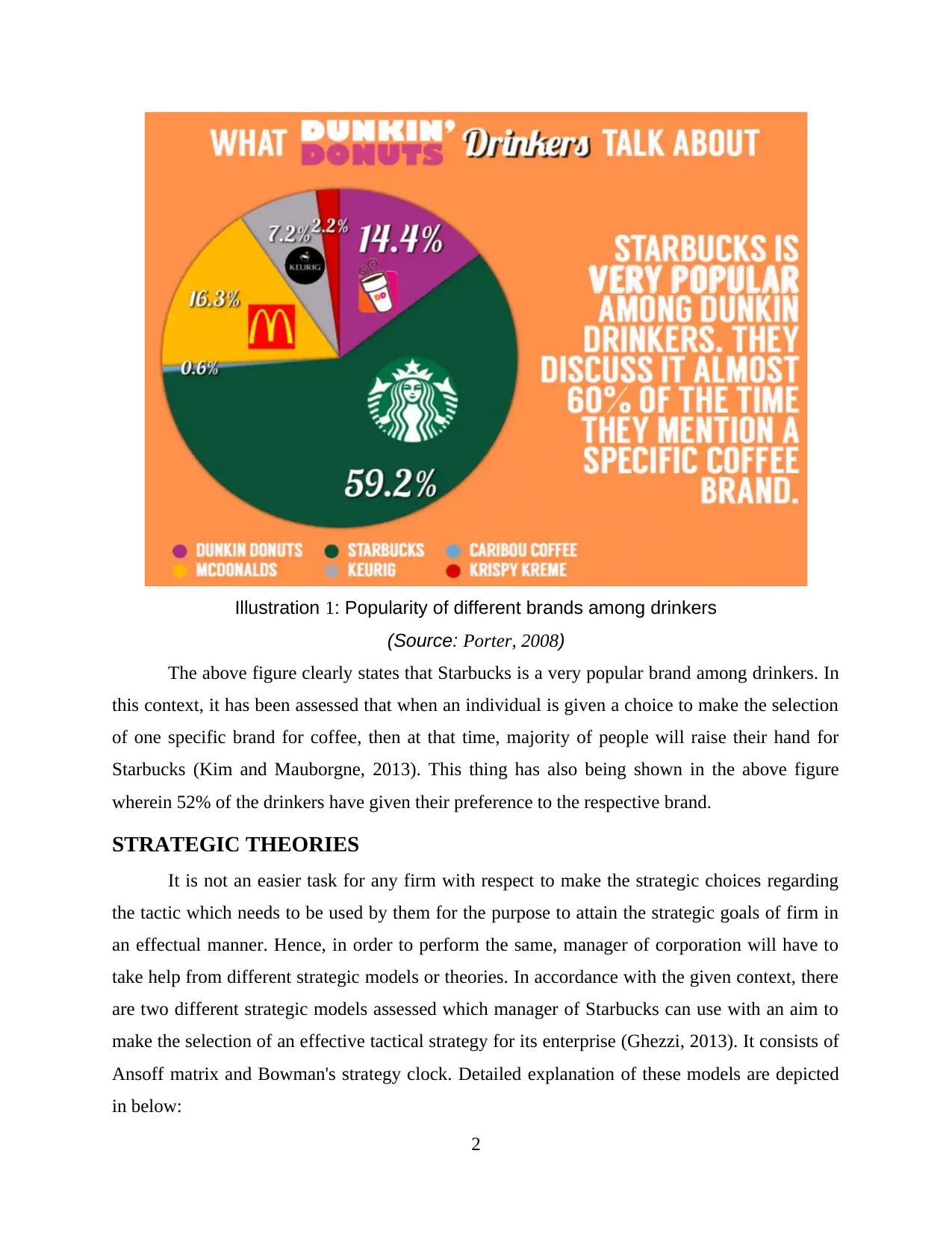
Illustration 1: Popularity of different brands among drinkers
(Source: Porter, 2008)
The above figure clearly states that Starbucks is a very popular brand among drinkers. In
this context, it has been assessed that when an individual is given a choice to make the selection
of one specific brand for coffee, then at that time, majority of people will raise their hand for
Starbucks (Kim and Mauborgne, 2013). This thing has also being shown in the above figure
wherein 52% of the drinkers have given their preference to the respective brand.
STRATEGIC THEORIES
It is not an easier task for any firm with respect to make the strategic choices regarding
the tactic which needs to be used by them for the purpose to attain the strategic goals of firm in
an effectual manner. Hence, in order to perform the same, manager of corporation will have to
take help from different strategic models or theories. In accordance with the given context, there
are two different strategic models assessed which manager of Starbucks can use with an aim to
make the selection of an effective tactical strategy for its enterprise (Ghezzi, 2013). It consists of
Ansoff matrix and Bowman's strategy clock. Detailed explanation of these models are depicted
in below:
2
(Source: Porter, 2008)
The above figure clearly states that Starbucks is a very popular brand among drinkers. In
this context, it has been assessed that when an individual is given a choice to make the selection
of one specific brand for coffee, then at that time, majority of people will raise their hand for
Starbucks (Kim and Mauborgne, 2013). This thing has also being shown in the above figure
wherein 52% of the drinkers have given their preference to the respective brand.
STRATEGIC THEORIES
It is not an easier task for any firm with respect to make the strategic choices regarding
the tactic which needs to be used by them for the purpose to attain the strategic goals of firm in
an effectual manner. Hence, in order to perform the same, manager of corporation will have to
take help from different strategic models or theories. In accordance with the given context, there
are two different strategic models assessed which manager of Starbucks can use with an aim to
make the selection of an effective tactical strategy for its enterprise (Ghezzi, 2013). It consists of
Ansoff matrix and Bowman's strategy clock. Detailed explanation of these models are depicted
in below:
2
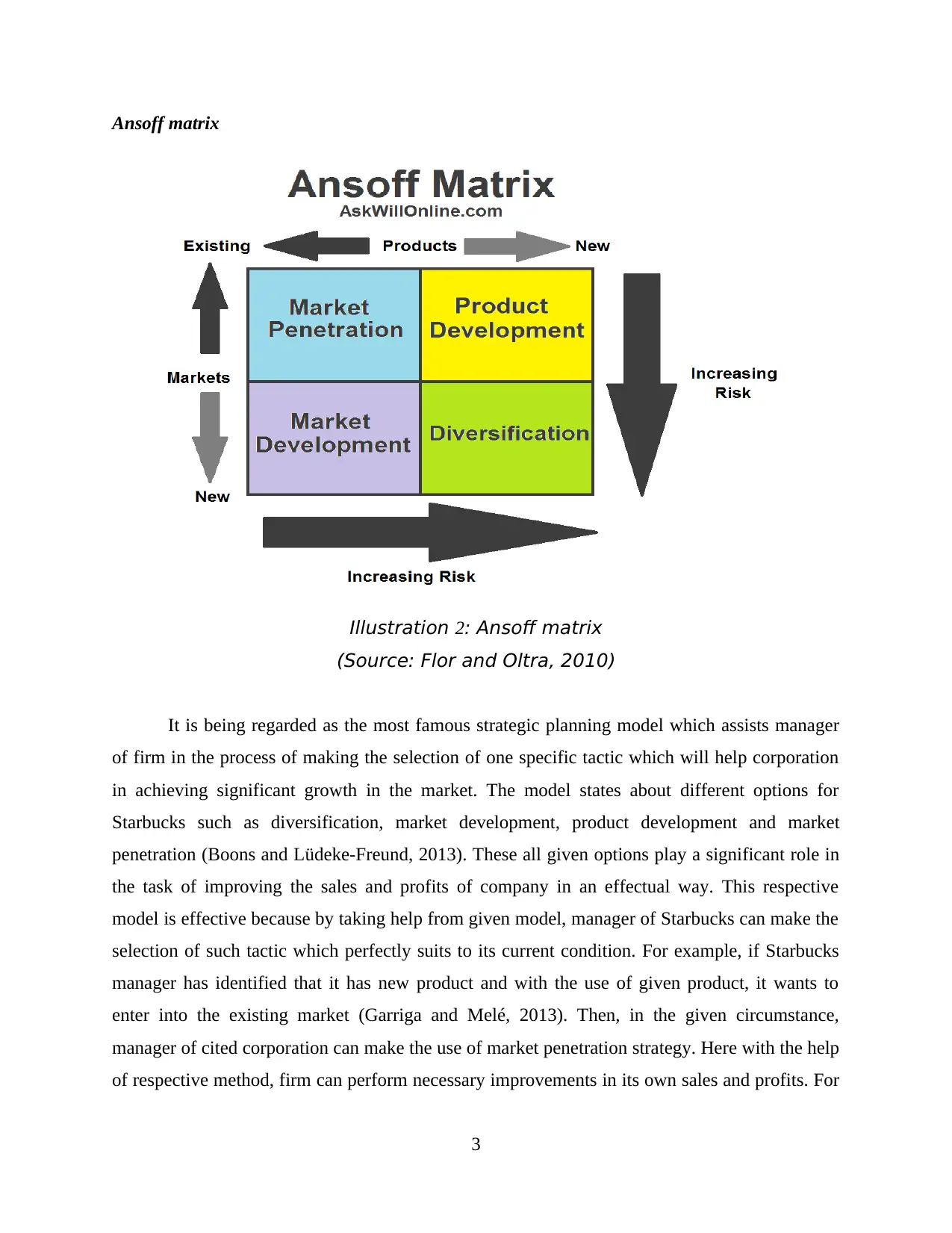
Ansoff matrix
It is being regarded as the most famous strategic planning model which assists manager
of firm in the process of making the selection of one specific tactic which will help corporation
in achieving significant growth in the market. The model states about different options for
Starbucks such as diversification, market development, product development and market
penetration (Boons and Lüdeke-Freund, 2013). These all given options play a significant role in
the task of improving the sales and profits of company in an effectual way. This respective
model is effective because by taking help from given model, manager of Starbucks can make the
selection of such tactic which perfectly suits to its current condition. For example, if Starbucks
manager has identified that it has new product and with the use of given product, it wants to
enter into the existing market (Garriga and Melé, 2013). Then, in the given circumstance,
manager of cited corporation can make the use of market penetration strategy. Here with the help
of respective method, firm can perform necessary improvements in its own sales and profits. For
3
Illustration 2: Ansoff matrix
(Source: Flor and Oltra, 2010)
It is being regarded as the most famous strategic planning model which assists manager
of firm in the process of making the selection of one specific tactic which will help corporation
in achieving significant growth in the market. The model states about different options for
Starbucks such as diversification, market development, product development and market
penetration (Boons and Lüdeke-Freund, 2013). These all given options play a significant role in
the task of improving the sales and profits of company in an effectual way. This respective
model is effective because by taking help from given model, manager of Starbucks can make the
selection of such tactic which perfectly suits to its current condition. For example, if Starbucks
manager has identified that it has new product and with the use of given product, it wants to
enter into the existing market (Garriga and Melé, 2013). Then, in the given circumstance,
manager of cited corporation can make the use of market penetration strategy. Here with the help
of respective method, firm can perform necessary improvements in its own sales and profits. For
3
Illustration 2: Ansoff matrix
(Source: Flor and Oltra, 2010)
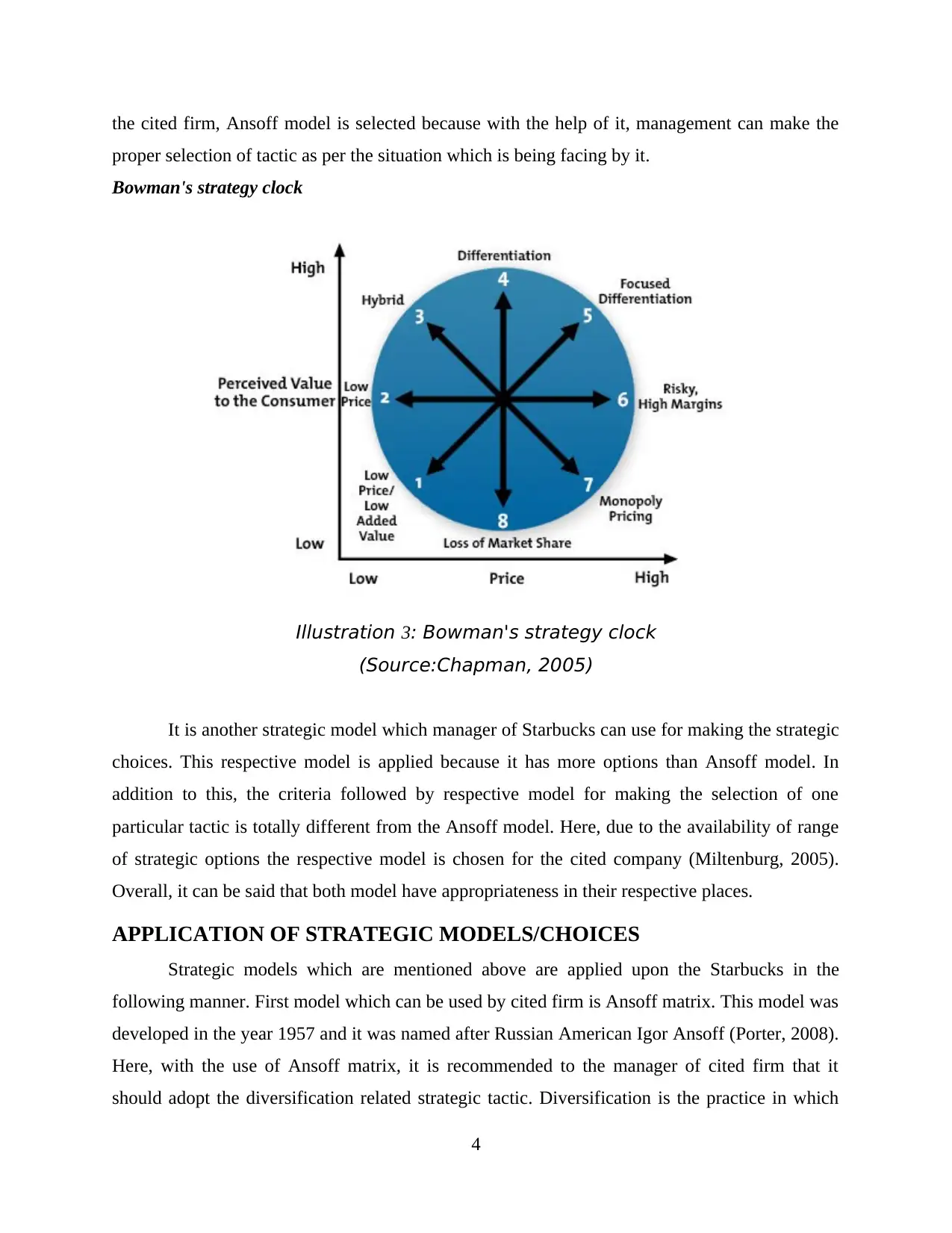
the cited firm, Ansoff model is selected because with the help of it, management can make the
proper selection of tactic as per the situation which is being facing by it.
Bowman's strategy clock
It is another strategic model which manager of Starbucks can use for making the strategic
choices. This respective model is applied because it has more options than Ansoff model. In
addition to this, the criteria followed by respective model for making the selection of one
particular tactic is totally different from the Ansoff model. Here, due to the availability of range
of strategic options the respective model is chosen for the cited company (Miltenburg, 2005).
Overall, it can be said that both model have appropriateness in their respective places.
APPLICATION OF STRATEGIC MODELS/CHOICES
Strategic models which are mentioned above are applied upon the Starbucks in the
following manner. First model which can be used by cited firm is Ansoff matrix. This model was
developed in the year 1957 and it was named after Russian American Igor Ansoff (Porter, 2008).
Here, with the use of Ansoff matrix, it is recommended to the manager of cited firm that it
should adopt the diversification related strategic tactic. Diversification is the practice in which
4
Illustration 3: Bowman's strategy clock
(Source:Chapman, 2005)
proper selection of tactic as per the situation which is being facing by it.
Bowman's strategy clock
It is another strategic model which manager of Starbucks can use for making the strategic
choices. This respective model is applied because it has more options than Ansoff model. In
addition to this, the criteria followed by respective model for making the selection of one
particular tactic is totally different from the Ansoff model. Here, due to the availability of range
of strategic options the respective model is chosen for the cited company (Miltenburg, 2005).
Overall, it can be said that both model have appropriateness in their respective places.
APPLICATION OF STRATEGIC MODELS/CHOICES
Strategic models which are mentioned above are applied upon the Starbucks in the
following manner. First model which can be used by cited firm is Ansoff matrix. This model was
developed in the year 1957 and it was named after Russian American Igor Ansoff (Porter, 2008).
Here, with the use of Ansoff matrix, it is recommended to the manager of cited firm that it
should adopt the diversification related strategic tactic. Diversification is the practice in which
4
Illustration 3: Bowman's strategy clock
(Source:Chapman, 2005)
Paraphrase This Document
Need a fresh take? Get an instant paraphrase of this document with our AI Paraphraser
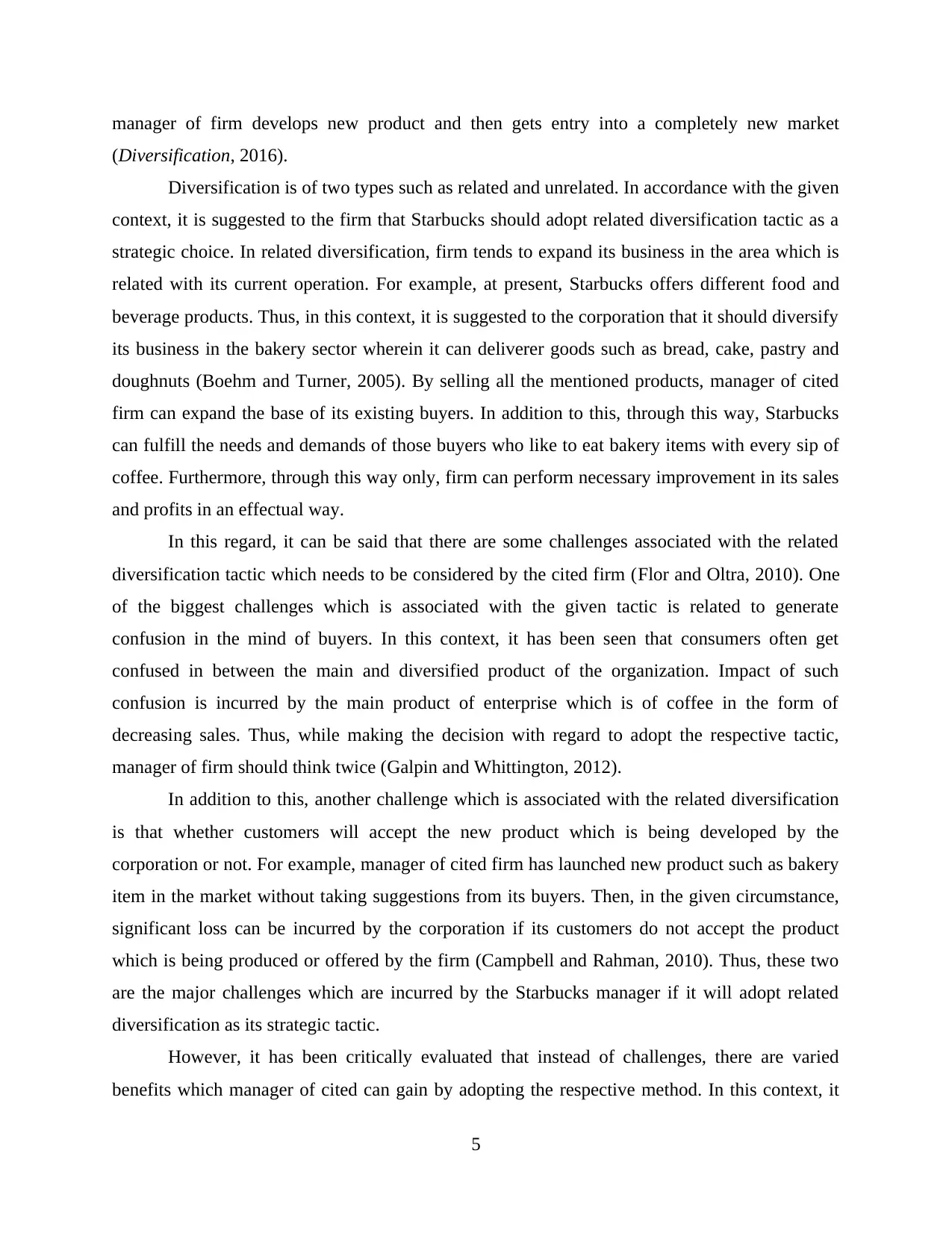
manager of firm develops new product and then gets entry into a completely new market
(Diversification, 2016).
Diversification is of two types such as related and unrelated. In accordance with the given
context, it is suggested to the firm that Starbucks should adopt related diversification tactic as a
strategic choice. In related diversification, firm tends to expand its business in the area which is
related with its current operation. For example, at present, Starbucks offers different food and
beverage products. Thus, in this context, it is suggested to the corporation that it should diversify
its business in the bakery sector wherein it can deliverer goods such as bread, cake, pastry and
doughnuts (Boehm and Turner, 2005). By selling all the mentioned products, manager of cited
firm can expand the base of its existing buyers. In addition to this, through this way, Starbucks
can fulfill the needs and demands of those buyers who like to eat bakery items with every sip of
coffee. Furthermore, through this way only, firm can perform necessary improvement in its sales
and profits in an effectual way.
In this regard, it can be said that there are some challenges associated with the related
diversification tactic which needs to be considered by the cited firm (Flor and Oltra, 2010). One
of the biggest challenges which is associated with the given tactic is related to generate
confusion in the mind of buyers. In this context, it has been seen that consumers often get
confused in between the main and diversified product of the organization. Impact of such
confusion is incurred by the main product of enterprise which is of coffee in the form of
decreasing sales. Thus, while making the decision with regard to adopt the respective tactic,
manager of firm should think twice (Galpin and Whittington, 2012).
In addition to this, another challenge which is associated with the related diversification
is that whether customers will accept the new product which is being developed by the
corporation or not. For example, manager of cited firm has launched new product such as bakery
item in the market without taking suggestions from its buyers. Then, in the given circumstance,
significant loss can be incurred by the corporation if its customers do not accept the product
which is being produced or offered by the firm (Campbell and Rahman, 2010). Thus, these two
are the major challenges which are incurred by the Starbucks manager if it will adopt related
diversification as its strategic tactic.
However, it has been critically evaluated that instead of challenges, there are varied
benefits which manager of cited can gain by adopting the respective method. In this context, it
5
(Diversification, 2016).
Diversification is of two types such as related and unrelated. In accordance with the given
context, it is suggested to the firm that Starbucks should adopt related diversification tactic as a
strategic choice. In related diversification, firm tends to expand its business in the area which is
related with its current operation. For example, at present, Starbucks offers different food and
beverage products. Thus, in this context, it is suggested to the corporation that it should diversify
its business in the bakery sector wherein it can deliverer goods such as bread, cake, pastry and
doughnuts (Boehm and Turner, 2005). By selling all the mentioned products, manager of cited
firm can expand the base of its existing buyers. In addition to this, through this way, Starbucks
can fulfill the needs and demands of those buyers who like to eat bakery items with every sip of
coffee. Furthermore, through this way only, firm can perform necessary improvement in its sales
and profits in an effectual way.
In this regard, it can be said that there are some challenges associated with the related
diversification tactic which needs to be considered by the cited firm (Flor and Oltra, 2010). One
of the biggest challenges which is associated with the given tactic is related to generate
confusion in the mind of buyers. In this context, it has been seen that consumers often get
confused in between the main and diversified product of the organization. Impact of such
confusion is incurred by the main product of enterprise which is of coffee in the form of
decreasing sales. Thus, while making the decision with regard to adopt the respective tactic,
manager of firm should think twice (Galpin and Whittington, 2012).
In addition to this, another challenge which is associated with the related diversification
is that whether customers will accept the new product which is being developed by the
corporation or not. For example, manager of cited firm has launched new product such as bakery
item in the market without taking suggestions from its buyers. Then, in the given circumstance,
significant loss can be incurred by the corporation if its customers do not accept the product
which is being produced or offered by the firm (Campbell and Rahman, 2010). Thus, these two
are the major challenges which are incurred by the Starbucks manager if it will adopt related
diversification as its strategic tactic.
However, it has been critically evaluated that instead of challenges, there are varied
benefits which manager of cited can gain by adopting the respective method. In this context, it
5
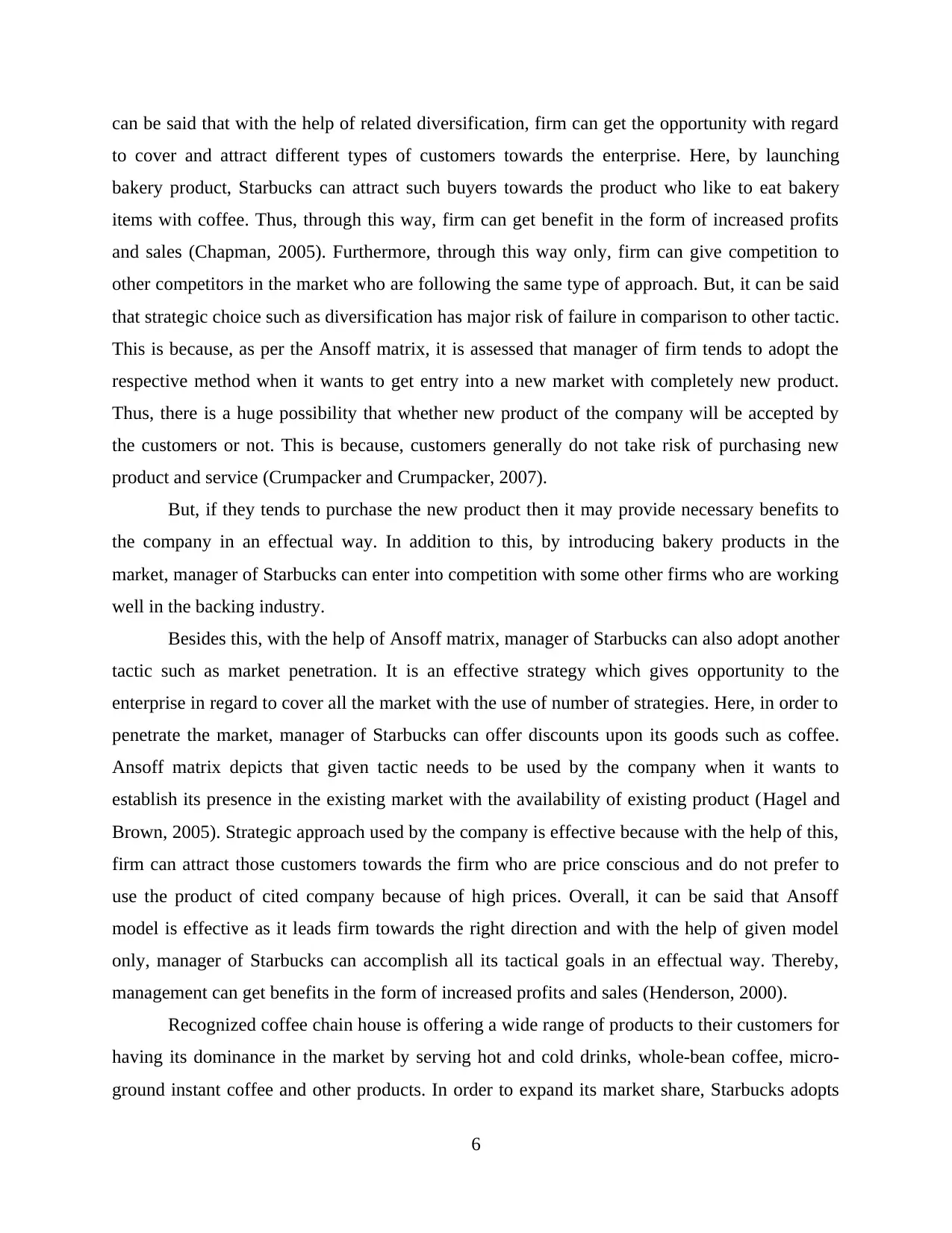
can be said that with the help of related diversification, firm can get the opportunity with regard
to cover and attract different types of customers towards the enterprise. Here, by launching
bakery product, Starbucks can attract such buyers towards the product who like to eat bakery
items with coffee. Thus, through this way, firm can get benefit in the form of increased profits
and sales (Chapman, 2005). Furthermore, through this way only, firm can give competition to
other competitors in the market who are following the same type of approach. But, it can be said
that strategic choice such as diversification has major risk of failure in comparison to other tactic.
This is because, as per the Ansoff matrix, it is assessed that manager of firm tends to adopt the
respective method when it wants to get entry into a new market with completely new product.
Thus, there is a huge possibility that whether new product of the company will be accepted by
the customers or not. This is because, customers generally do not take risk of purchasing new
product and service (Crumpacker and Crumpacker, 2007).
But, if they tends to purchase the new product then it may provide necessary benefits to
the company in an effectual way. In addition to this, by introducing bakery products in the
market, manager of Starbucks can enter into competition with some other firms who are working
well in the backing industry.
Besides this, with the help of Ansoff matrix, manager of Starbucks can also adopt another
tactic such as market penetration. It is an effective strategy which gives opportunity to the
enterprise in regard to cover all the market with the use of number of strategies. Here, in order to
penetrate the market, manager of Starbucks can offer discounts upon its goods such as coffee.
Ansoff matrix depicts that given tactic needs to be used by the company when it wants to
establish its presence in the existing market with the availability of existing product (Hagel and
Brown, 2005). Strategic approach used by the company is effective because with the help of this,
firm can attract those customers towards the firm who are price conscious and do not prefer to
use the product of cited company because of high prices. Overall, it can be said that Ansoff
model is effective as it leads firm towards the right direction and with the help of given model
only, manager of Starbucks can accomplish all its tactical goals in an effectual way. Thereby,
management can get benefits in the form of increased profits and sales (Henderson, 2000).
Recognized coffee chain house is offering a wide range of products to their customers for
having its dominance in the market by serving hot and cold drinks, whole-bean coffee, micro-
ground instant coffee and other products. In order to expand its market share, Starbucks adopts
6
to cover and attract different types of customers towards the enterprise. Here, by launching
bakery product, Starbucks can attract such buyers towards the product who like to eat bakery
items with coffee. Thus, through this way, firm can get benefit in the form of increased profits
and sales (Chapman, 2005). Furthermore, through this way only, firm can give competition to
other competitors in the market who are following the same type of approach. But, it can be said
that strategic choice such as diversification has major risk of failure in comparison to other tactic.
This is because, as per the Ansoff matrix, it is assessed that manager of firm tends to adopt the
respective method when it wants to get entry into a new market with completely new product.
Thus, there is a huge possibility that whether new product of the company will be accepted by
the customers or not. This is because, customers generally do not take risk of purchasing new
product and service (Crumpacker and Crumpacker, 2007).
But, if they tends to purchase the new product then it may provide necessary benefits to
the company in an effectual way. In addition to this, by introducing bakery products in the
market, manager of Starbucks can enter into competition with some other firms who are working
well in the backing industry.
Besides this, with the help of Ansoff matrix, manager of Starbucks can also adopt another
tactic such as market penetration. It is an effective strategy which gives opportunity to the
enterprise in regard to cover all the market with the use of number of strategies. Here, in order to
penetrate the market, manager of Starbucks can offer discounts upon its goods such as coffee.
Ansoff matrix depicts that given tactic needs to be used by the company when it wants to
establish its presence in the existing market with the availability of existing product (Hagel and
Brown, 2005). Strategic approach used by the company is effective because with the help of this,
firm can attract those customers towards the firm who are price conscious and do not prefer to
use the product of cited company because of high prices. Overall, it can be said that Ansoff
model is effective as it leads firm towards the right direction and with the help of given model
only, manager of Starbucks can accomplish all its tactical goals in an effectual way. Thereby,
management can get benefits in the form of increased profits and sales (Henderson, 2000).
Recognized coffee chain house is offering a wide range of products to their customers for
having its dominance in the market by serving hot and cold drinks, whole-bean coffee, micro-
ground instant coffee and other products. In order to expand its market share, Starbucks adopts
6
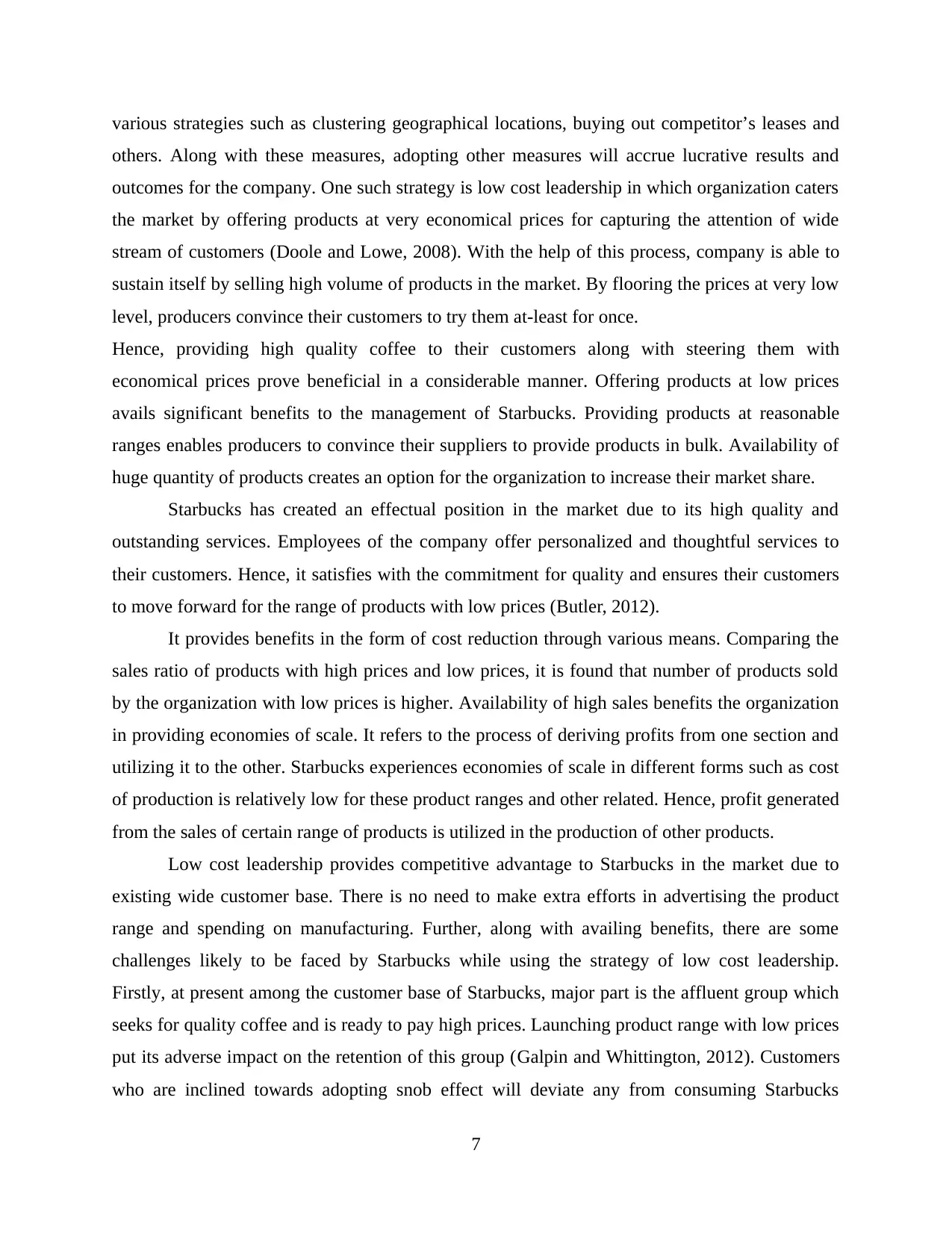
various strategies such as clustering geographical locations, buying out competitor’s leases and
others. Along with these measures, adopting other measures will accrue lucrative results and
outcomes for the company. One such strategy is low cost leadership in which organization caters
the market by offering products at very economical prices for capturing the attention of wide
stream of customers (Doole and Lowe, 2008). With the help of this process, company is able to
sustain itself by selling high volume of products in the market. By flooring the prices at very low
level, producers convince their customers to try them at-least for once.
Hence, providing high quality coffee to their customers along with steering them with
economical prices prove beneficial in a considerable manner. Offering products at low prices
avails significant benefits to the management of Starbucks. Providing products at reasonable
ranges enables producers to convince their suppliers to provide products in bulk. Availability of
huge quantity of products creates an option for the organization to increase their market share.
Starbucks has created an effectual position in the market due to its high quality and
outstanding services. Employees of the company offer personalized and thoughtful services to
their customers. Hence, it satisfies with the commitment for quality and ensures their customers
to move forward for the range of products with low prices (Butler, 2012).
It provides benefits in the form of cost reduction through various means. Comparing the
sales ratio of products with high prices and low prices, it is found that number of products sold
by the organization with low prices is higher. Availability of high sales benefits the organization
in providing economies of scale. It refers to the process of deriving profits from one section and
utilizing it to the other. Starbucks experiences economies of scale in different forms such as cost
of production is relatively low for these product ranges and other related. Hence, profit generated
from the sales of certain range of products is utilized in the production of other products.
Low cost leadership provides competitive advantage to Starbucks in the market due to
existing wide customer base. There is no need to make extra efforts in advertising the product
range and spending on manufacturing. Further, along with availing benefits, there are some
challenges likely to be faced by Starbucks while using the strategy of low cost leadership.
Firstly, at present among the customer base of Starbucks, major part is the affluent group which
seeks for quality coffee and is ready to pay high prices. Launching product range with low prices
put its adverse impact on the retention of this group (Galpin and Whittington, 2012). Customers
who are inclined towards adopting snob effect will deviate any from consuming Starbucks
7
others. Along with these measures, adopting other measures will accrue lucrative results and
outcomes for the company. One such strategy is low cost leadership in which organization caters
the market by offering products at very economical prices for capturing the attention of wide
stream of customers (Doole and Lowe, 2008). With the help of this process, company is able to
sustain itself by selling high volume of products in the market. By flooring the prices at very low
level, producers convince their customers to try them at-least for once.
Hence, providing high quality coffee to their customers along with steering them with
economical prices prove beneficial in a considerable manner. Offering products at low prices
avails significant benefits to the management of Starbucks. Providing products at reasonable
ranges enables producers to convince their suppliers to provide products in bulk. Availability of
huge quantity of products creates an option for the organization to increase their market share.
Starbucks has created an effectual position in the market due to its high quality and
outstanding services. Employees of the company offer personalized and thoughtful services to
their customers. Hence, it satisfies with the commitment for quality and ensures their customers
to move forward for the range of products with low prices (Butler, 2012).
It provides benefits in the form of cost reduction through various means. Comparing the
sales ratio of products with high prices and low prices, it is found that number of products sold
by the organization with low prices is higher. Availability of high sales benefits the organization
in providing economies of scale. It refers to the process of deriving profits from one section and
utilizing it to the other. Starbucks experiences economies of scale in different forms such as cost
of production is relatively low for these product ranges and other related. Hence, profit generated
from the sales of certain range of products is utilized in the production of other products.
Low cost leadership provides competitive advantage to Starbucks in the market due to
existing wide customer base. There is no need to make extra efforts in advertising the product
range and spending on manufacturing. Further, along with availing benefits, there are some
challenges likely to be faced by Starbucks while using the strategy of low cost leadership.
Firstly, at present among the customer base of Starbucks, major part is the affluent group which
seeks for quality coffee and is ready to pay high prices. Launching product range with low prices
put its adverse impact on the retention of this group (Galpin and Whittington, 2012). Customers
who are inclined towards adopting snob effect will deviate any from consuming Starbucks
7
Secure Best Marks with AI Grader
Need help grading? Try our AI Grader for instant feedback on your assignments.
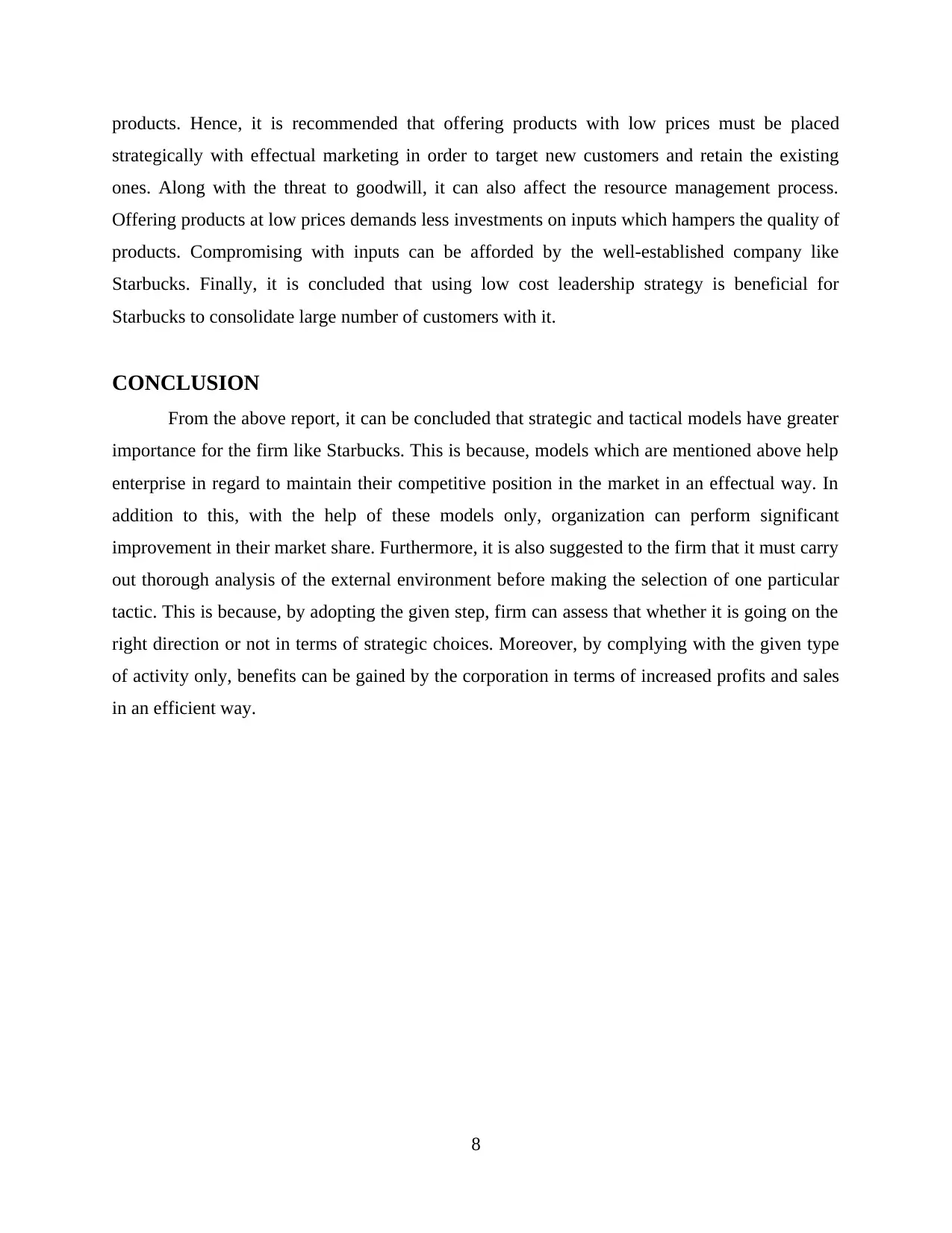
products. Hence, it is recommended that offering products with low prices must be placed
strategically with effectual marketing in order to target new customers and retain the existing
ones. Along with the threat to goodwill, it can also affect the resource management process.
Offering products at low prices demands less investments on inputs which hampers the quality of
products. Compromising with inputs can be afforded by the well-established company like
Starbucks. Finally, it is concluded that using low cost leadership strategy is beneficial for
Starbucks to consolidate large number of customers with it.
CONCLUSION
From the above report, it can be concluded that strategic and tactical models have greater
importance for the firm like Starbucks. This is because, models which are mentioned above help
enterprise in regard to maintain their competitive position in the market in an effectual way. In
addition to this, with the help of these models only, organization can perform significant
improvement in their market share. Furthermore, it is also suggested to the firm that it must carry
out thorough analysis of the external environment before making the selection of one particular
tactic. This is because, by adopting the given step, firm can assess that whether it is going on the
right direction or not in terms of strategic choices. Moreover, by complying with the given type
of activity only, benefits can be gained by the corporation in terms of increased profits and sales
in an efficient way.
8
strategically with effectual marketing in order to target new customers and retain the existing
ones. Along with the threat to goodwill, it can also affect the resource management process.
Offering products at low prices demands less investments on inputs which hampers the quality of
products. Compromising with inputs can be afforded by the well-established company like
Starbucks. Finally, it is concluded that using low cost leadership strategy is beneficial for
Starbucks to consolidate large number of customers with it.
CONCLUSION
From the above report, it can be concluded that strategic and tactical models have greater
importance for the firm like Starbucks. This is because, models which are mentioned above help
enterprise in regard to maintain their competitive position in the market in an effectual way. In
addition to this, with the help of these models only, organization can perform significant
improvement in their market share. Furthermore, it is also suggested to the firm that it must carry
out thorough analysis of the external environment before making the selection of one particular
tactic. This is because, by adopting the given step, firm can assess that whether it is going on the
right direction or not in terms of strategic choices. Moreover, by complying with the given type
of activity only, benefits can be gained by the corporation in terms of increased profits and sales
in an efficient way.
8
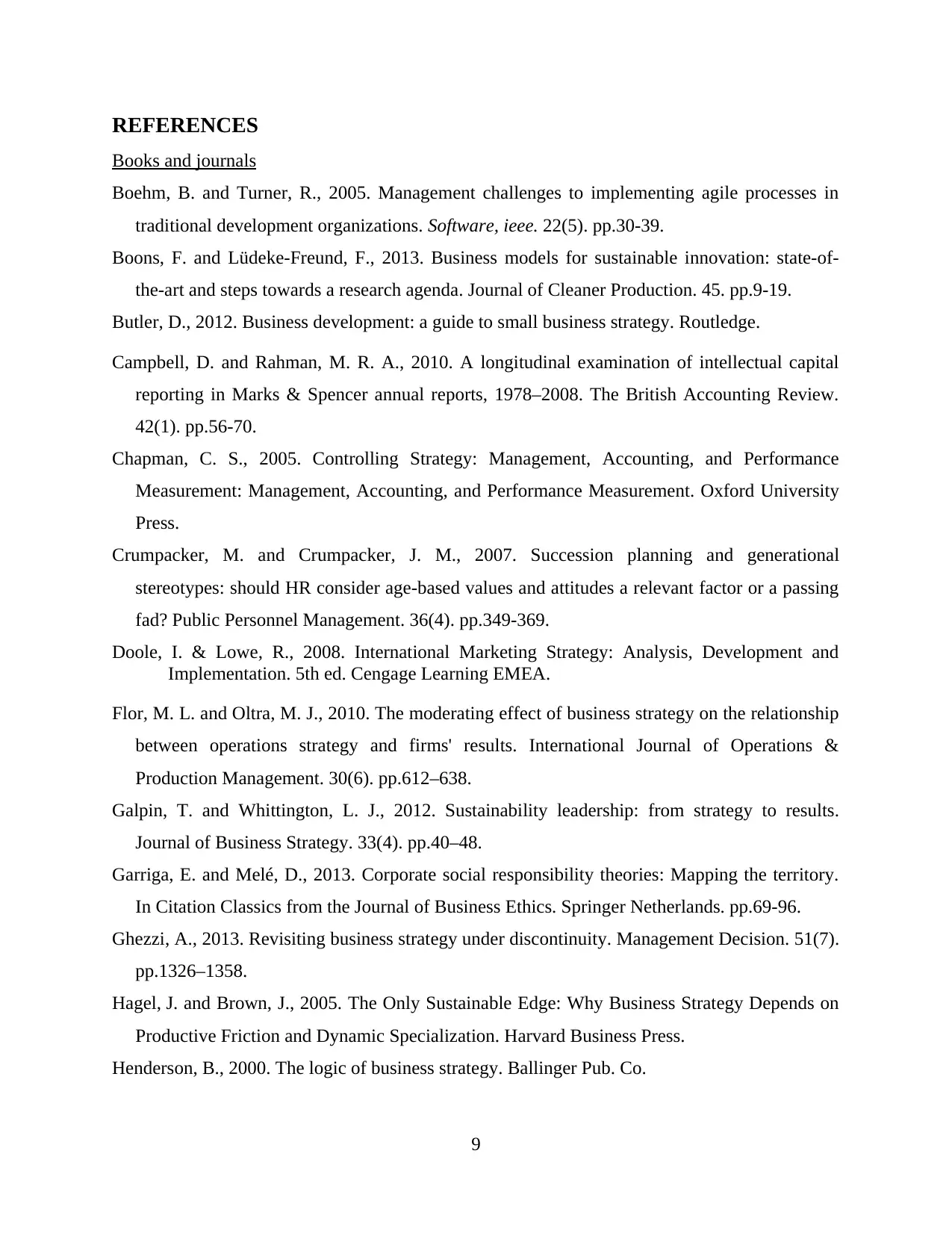
REFERENCES
Books and journals
Boehm, B. and Turner, R., 2005. Management challenges to implementing agile processes in
traditional development organizations. Software, ieee. 22(5). pp.30-39.
Boons, F. and Lüdeke-Freund, F., 2013. Business models for sustainable innovation: state-of-
the-art and steps towards a research agenda. Journal of Cleaner Production. 45. pp.9-19.
Butler, D., 2012. Business development: a guide to small business strategy. Routledge.
Campbell, D. and Rahman, M. R. A., 2010. A longitudinal examination of intellectual capital
reporting in Marks & Spencer annual reports, 1978–2008. The British Accounting Review.
42(1). pp.56-70.
Chapman, C. S., 2005. Controlling Strategy: Management, Accounting, and Performance
Measurement: Management, Accounting, and Performance Measurement. Oxford University
Press.
Crumpacker, M. and Crumpacker, J. M., 2007. Succession planning and generational
stereotypes: should HR consider age-based values and attitudes a relevant factor or a passing
fad? Public Personnel Management. 36(4). pp.349-369.
Doole, I. & Lowe, R., 2008. International Marketing Strategy: Analysis, Development and
Implementation. 5th ed. Cengage Learning EMEA.
Flor, M. L. and Oltra, M. J., 2010. The moderating effect of business strategy on the relationship
between operations strategy and firms' results. International Journal of Operations &
Production Management. 30(6). pp.612–638.
Galpin, T. and Whittington, L. J., 2012. Sustainability leadership: from strategy to results.
Journal of Business Strategy. 33(4). pp.40–48.
Garriga, E. and Melé, D., 2013. Corporate social responsibility theories: Mapping the territory.
In Citation Classics from the Journal of Business Ethics. Springer Netherlands. pp.69-96.
Ghezzi, A., 2013. Revisiting business strategy under discontinuity. Management Decision. 51(7).
pp.1326–1358.
Hagel, J. and Brown, J., 2005. The Only Sustainable Edge: Why Business Strategy Depends on
Productive Friction and Dynamic Specialization. Harvard Business Press.
Henderson, B., 2000. The logic of business strategy. Ballinger Pub. Co.
9
Books and journals
Boehm, B. and Turner, R., 2005. Management challenges to implementing agile processes in
traditional development organizations. Software, ieee. 22(5). pp.30-39.
Boons, F. and Lüdeke-Freund, F., 2013. Business models for sustainable innovation: state-of-
the-art and steps towards a research agenda. Journal of Cleaner Production. 45. pp.9-19.
Butler, D., 2012. Business development: a guide to small business strategy. Routledge.
Campbell, D. and Rahman, M. R. A., 2010. A longitudinal examination of intellectual capital
reporting in Marks & Spencer annual reports, 1978–2008. The British Accounting Review.
42(1). pp.56-70.
Chapman, C. S., 2005. Controlling Strategy: Management, Accounting, and Performance
Measurement: Management, Accounting, and Performance Measurement. Oxford University
Press.
Crumpacker, M. and Crumpacker, J. M., 2007. Succession planning and generational
stereotypes: should HR consider age-based values and attitudes a relevant factor or a passing
fad? Public Personnel Management. 36(4). pp.349-369.
Doole, I. & Lowe, R., 2008. International Marketing Strategy: Analysis, Development and
Implementation. 5th ed. Cengage Learning EMEA.
Flor, M. L. and Oltra, M. J., 2010. The moderating effect of business strategy on the relationship
between operations strategy and firms' results. International Journal of Operations &
Production Management. 30(6). pp.612–638.
Galpin, T. and Whittington, L. J., 2012. Sustainability leadership: from strategy to results.
Journal of Business Strategy. 33(4). pp.40–48.
Garriga, E. and Melé, D., 2013. Corporate social responsibility theories: Mapping the territory.
In Citation Classics from the Journal of Business Ethics. Springer Netherlands. pp.69-96.
Ghezzi, A., 2013. Revisiting business strategy under discontinuity. Management Decision. 51(7).
pp.1326–1358.
Hagel, J. and Brown, J., 2005. The Only Sustainable Edge: Why Business Strategy Depends on
Productive Friction and Dynamic Specialization. Harvard Business Press.
Henderson, B., 2000. The logic of business strategy. Ballinger Pub. Co.
9
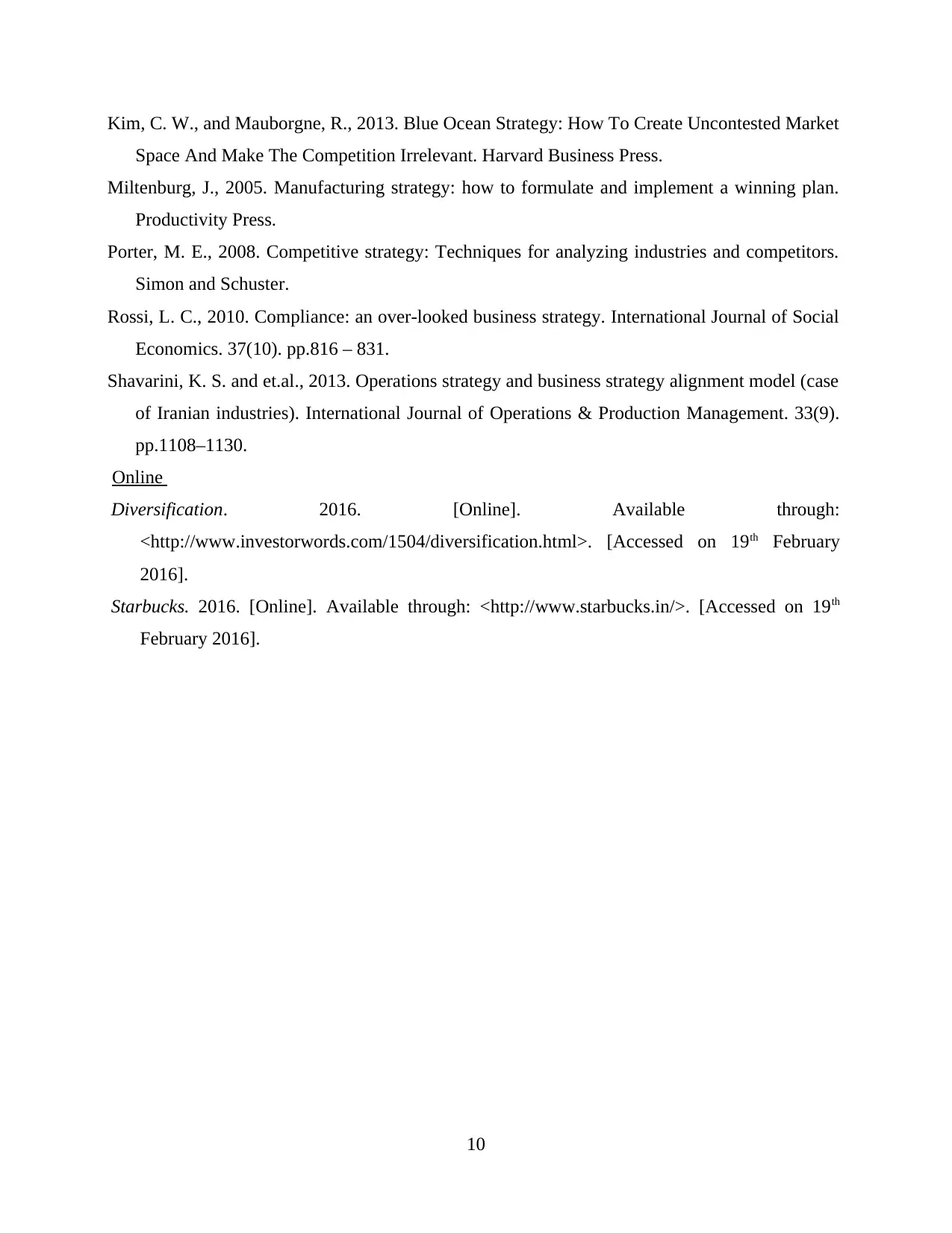
Kim, C. W., and Mauborgne, R., 2013. Blue Ocean Strategy: How To Create Uncontested Market
Space And Make The Competition Irrelevant. Harvard Business Press.
Miltenburg, J., 2005. Manufacturing strategy: how to formulate and implement a winning plan.
Productivity Press.
Porter, M. E., 2008. Competitive strategy: Techniques for analyzing industries and competitors.
Simon and Schuster.
Rossi, L. C., 2010. Compliance: an over-looked business strategy. International Journal of Social
Economics. 37(10). pp.816 – 831.
Shavarini, K. S. and et.al., 2013. Operations strategy and business strategy alignment model (case
of Iranian industries). International Journal of Operations & Production Management. 33(9).
pp.1108–1130.
Online
Diversification. 2016. [Online]. Available through:
<http://www.investorwords.com/1504/diversification.html>. [Accessed on 19th February
2016].
Starbucks. 2016. [Online]. Available through: <http://www.starbucks.in/>. [Accessed on 19th
February 2016].
10
Space And Make The Competition Irrelevant. Harvard Business Press.
Miltenburg, J., 2005. Manufacturing strategy: how to formulate and implement a winning plan.
Productivity Press.
Porter, M. E., 2008. Competitive strategy: Techniques for analyzing industries and competitors.
Simon and Schuster.
Rossi, L. C., 2010. Compliance: an over-looked business strategy. International Journal of Social
Economics. 37(10). pp.816 – 831.
Shavarini, K. S. and et.al., 2013. Operations strategy and business strategy alignment model (case
of Iranian industries). International Journal of Operations & Production Management. 33(9).
pp.1108–1130.
Online
Diversification. 2016. [Online]. Available through:
<http://www.investorwords.com/1504/diversification.html>. [Accessed on 19th February
2016].
Starbucks. 2016. [Online]. Available through: <http://www.starbucks.in/>. [Accessed on 19th
February 2016].
10
1 out of 13
Related Documents
Your All-in-One AI-Powered Toolkit for Academic Success.
+13062052269
info@desklib.com
Available 24*7 on WhatsApp / Email
![[object Object]](/_next/static/media/star-bottom.7253800d.svg)
Unlock your academic potential
© 2024 | Zucol Services PVT LTD | All rights reserved.




